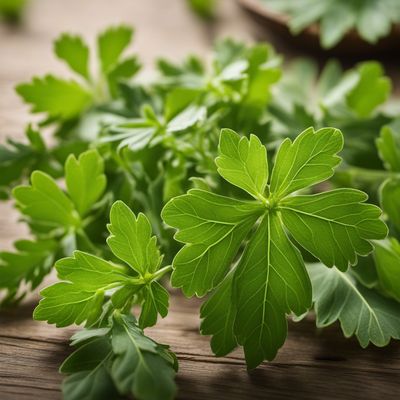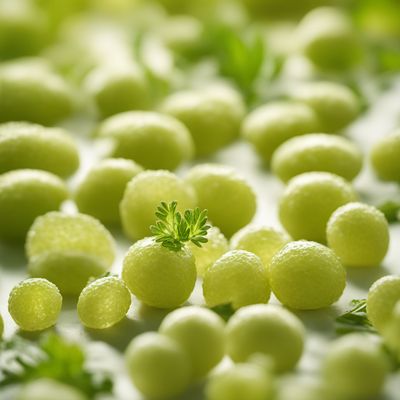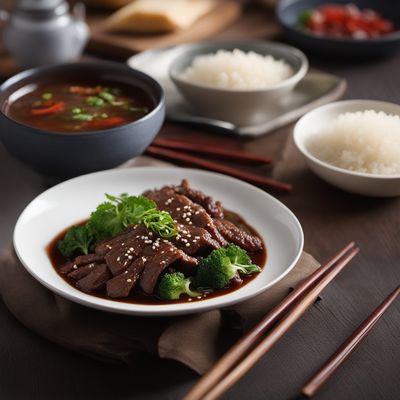
Ingredient
Marjoram, dry
Discovering the Aromatic Delights of Dry Marjoram
Dry marjoram has a delicate appearance, with small, green leaves that resemble oregano. It has a subtle yet distinct flavor, combining hints of citrus, pine, and sweetness. This herb is often used in Mediterranean and Middle Eastern cuisines, where it adds depth and complexity to soups, stews, roasted meats, and vegetable dishes.
Origins and history
Marjoram has a long history that dates back to ancient times. It was highly regarded by the ancient Greeks and Romans, who believed it had medicinal properties and used it in various culinary preparations. Marjoram has since become a staple herb in Mediterranean and Middle Eastern cuisines, where it is cherished for its aromatic qualities.
Nutritional information
Dry marjoram is low in calories and fat, making it a healthy addition to meals. It contains essential vitamins and minerals, including vitamin K, iron, and calcium. This herb also possesses antioxidant properties that contribute to overall health and well-being.
Allergens
There are no known allergens associated with dry marjoram, making it a safe choice for individuals with common food allergies. However, as with any herb or spice, it's important to use it in moderation and be mindful of any potential sensitivities or adverse reactions.
How to select
When selecting dry marjoram, look for packages that are tightly sealed and free from any signs of moisture or clumping. The herb should have a vibrant green color and a strong, aromatic scent. It's best to purchase dry marjoram from reputable brands or suppliers to ensure its quality and freshness.
Storage recommendations
To maintain the flavor and aroma of dry marjoram, store it in an airtight container in a cool, dark place, away from direct sunlight. Proper storage will help preserve its freshness and extend its shelf life. Avoid crushing or grinding the herb until you are ready to use it, as this will help retain its essential oils.
How to produce
Growing marjoram at home is relatively easy, as it can be grown in containers or in the garden. This herb prefers well-drained soil and requires full sun to thrive. Regular pruning will help promote bushier growth and ensure a steady supply of fresh leaves. Harvest the leaves as needed and dry them for future use.
Preparation tips
Dry marjoram can be used in a variety of dishes, including soups, stews, roasted meats, and vegetable dishes. It pairs well with ingredients such as tomatoes, garlic, onions, and olive oil. This herb can also be used to infuse oils, vinegars, and marinades, adding a delightful aroma and flavor to dressings and sauces.
Culinary uses
Dry marjoram is commonly used in Mediterranean and Middle Eastern cuisines. It is a key ingredient in dishes such as Italian pasta sauces, Greek souvlaki, and Moroccan tagines. This herb is also used in spice blends like za'atar and herbes de Provence. Its versatility makes it a popular choice among chefs and home cooks alike.
Availability
Dry marjoram is widely available in grocery stores, supermarkets, and online retailers that offer herbs and spices. It is cultivated in various regions around the world, including the Mediterranean, North Africa, and parts of Asia.
More ingredients from this category » Browse all

Angelica, dry
The Heavenly Herb: Unveiling the Secrets of Dry Angelica

Mints, dry
The Versatile Herb: Unlocking the Aromatic Power of Dry Mints

Celery leaves, dry
The Flavorful Herb: Dry Celery Leaves

Borage, dry
The Vibrant Herb of Delight

Wormwoods, dry
The Bitter Herb: Wormwoods

Wintergreen leaves, dry
Nature's Minty Delight

Fennel, dry
The Fragrant Spice of the Mediterranean

Balm leaves, dry
The Soothing Herb: Balm Leaves

Rosemary, dry
"The Fragrant Herb: Unveiling the Secrets of Dried Rosemary"

Lovage, dry
The Aromatic Herb: Lovage

Sage, dry
The Timeless Herb: Unveiling the Versatility of Dry Sage

Rue, dry
The Bitter Herb: Unveiling the Secrets of Dry Rue
Recipes using Marjoram, dry

Braised Duck Rice
Savory Delights: Fragrant Braised Duck Rice

Chen Pi Beef with a Devon Twist
Devonshire Chen Pi Beef: A Fusion of Chinese and West Country Flavors

Shandong-style Crispy Meat Pancakes
Golden Crispy Meat Pancakes: A Shandong Delight

Anhui-style Crispy Rice Cake with Chicken (Tahchin)
Golden Crispy Rice Delight with Tender Chicken - Anhui-style Tahchin